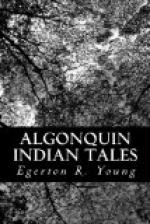“Yes, it is true,” he began, “that there did once live on this earth, both in the land and in the water, great animals like those here shown in this book. I have been to the wigwam of the great Shuniou and from him I have learned much about them, as handed down in the tradition of our forefathers. Great and terrible were they, and the people of those times lived in great terror of them, for the bows and arrows and even the stone war clubs of the strongest warriors were powerless to kill or even dangerously wound such monsters. It was well for the inhabitants of the earth in those days that these great monsters were few in number and that they were constantly fighting among themselves, for so large and terrible were they that only animals as big and fierce of other kinds could battle with them.
“But there was one great monster that lived in the water, and as he had no enemies big enough to attack him he lived on, even long after the other great animals were all killed off.
“Shuniou said that the tradition was that a great rush of waters caused many of the last of the great monsters that had tusks of ivory to be carried to the far Northland, and there, as the terribly cold winter set in, they were all frozen to death.
“This must be true,” added Souwanas, “for it was not many years ago that the Hudson Bay Company sent their men there to get this ivory, which they intended to ship to England. They came back with word that some of the dead bodies had been seen where the ice broke up. But this great monster in the water, as I have said, lived on after the rest were all supposed to have died off or been killed. He was a terrible scourge to those Indians whose wigwams were on the shores of the great sea in which he lived. They were in mortal terror when they ventured out in their canoes to fish. This they had to do, as they depended almost entirely on fish for their living, and there were times when the fish left the shallow waters near the shore and went out far from land. There the Indians had to follow and catch them or they and their families would starve.
“Happily for them, sometimes for months together no one would hear or see anything of this great sea monster. Then, perhaps, suddenly he would rise up right under a canoe in which were several Indians, whom he would easily catch and swallow one by one. He would sometimes rush after a herd of deer that had gone out swimming in the waters. He would catch and easily swallow several of them.”
“Well, I should think that the big horns of a moose or reindeer would give him some trouble to swallow,” said Sagastao.
“He was so large,” said Souwanas, “that the horns or body of the largest deer did not seem to bother him in the least degree.”
“I wonder if it were not one of his great grandfathers that swallowed Jonah,” said the observant Minnehaha.
“The Indians at length came to be so much distressed by the loss of so many of their number, and by their inability to slay the monster, that they resolved to ask Nanahboozhoo to come and help them if he possibly could.




